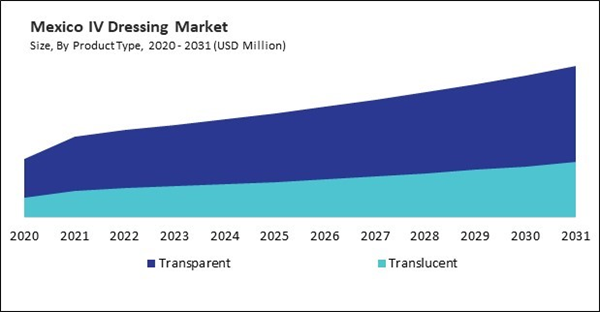In hospitals, IV dressings play a pivotal role within the market, serving as indispensable tools in patient care. These dressings are essential for safeguarding intravenous access points, providing a protective barrier against contaminants that could lead to infections. They ensure the secure fixation of IV catheters, preventing accidental displacement and maintaining the integrity of treatment delivery. Therefore, the hospitals in US consumed 6,745.1 thousand units of these dressings in 2023.
The US market dominated the North America IV Dressing Market by Country in 2023, and would continue to be a dominant market till 2031; thereby, achieving a market value of $360.1 Million by 2031. The Canada market is experiencing a CAGR of 7.6% during (2024 - 2031). Additionally, The Mexico market would exhibit a CAGR of 6.7% during (2024 - 2031).
IV therapy is a popular method for providing blood products, fluids, and drugs straight into the bloodstream. As IV therapy becomes more widely used in various healthcare settings, including clinics, hospitals, and home healthcare, dressings are becoming increasingly in demand. The dressings play a crucial role in preventing infections at the insertion site of IV catheters. They provide a barrier against bacteria and other pathogens, reducing the risk of bloodstream infections (BSIs) and other complications associated with IV therapy.
IV dressings are primarily used to prevent infections at the site where an IV catheter is inserted into a patient’s vein. They create a barrier that helps to minimize the risk of contamination by bacteria and other pathogens, reducing the incidence of bloodstream. This protects the insertion site from external contaminants and provide a supportive environment for wound healing. They support preserving a moist wound environment, which promotes tissue regeneration and repair.
According to the Canadian Institute for Health Information, Canada’s senior population of those 65 and older will expand by 68% over the next 20 years. It has more than tripled in size in the last 40 years. In 2017, it was around 6.2 million. It is anticipated to reach 10.4 million in 2037. This population in Canada is projected to increase by 2.1 times by 2037 from its size in 2017. Older adults may experience longer hospital stays than younger patient populations due to the complexity of their health conditions and the need for comprehensive care in Canada. Prolonged hospitalizations increase the duration of intravenous therapy, necessitating the use of dressings to maintain catheter integrity and reduce the risk of infection in Canada. The expanding senior population contributes to the increased demand for this in hospital settings in Canada. Hence, the factors mentioned above will drive the regional market growth.
Based on Type, the market is segmented into Transparent, and Translucent. Based on End-use, the market is segmented into Hospitals, Clinics, and Others. Based on countries, the market is segmented into U.S., Mexico, Canada, and Rest of North America.
List of Key Companies Profiled
- 3M Company
- Cardinal Health, Inc.
- Smith & Nephew PLC
- McKesson Corporation
- Covalon Technologies Ltd.
- Becton, Dickinson, and Company
- Molnlycke Health Care AB
- DermaRite Industries, LLC
- Dynarex Corporation
- Essity AB (BSN medical)
Market Report Segmentation
By Type (Volume, Thousand Units, USD Billion, 2020-2031)- Transparent
- Translucent
- Hospitals
- Clinics
- Others
- US
- Canada
- Mexico
- Rest of North America
Table of Contents
Companies Mentioned
- 3M Company
- Cardinal Health, Inc.
- Smith & Nephew PLC
- McKesson Corporation
- Covalon Technologies Ltd.
- Becton, Dickinson, and Company
- Molnlycke Health Care AB
- DermaRite Industries, LLC
- Dynarex Corporation
- Essity AB (BSN medical)









